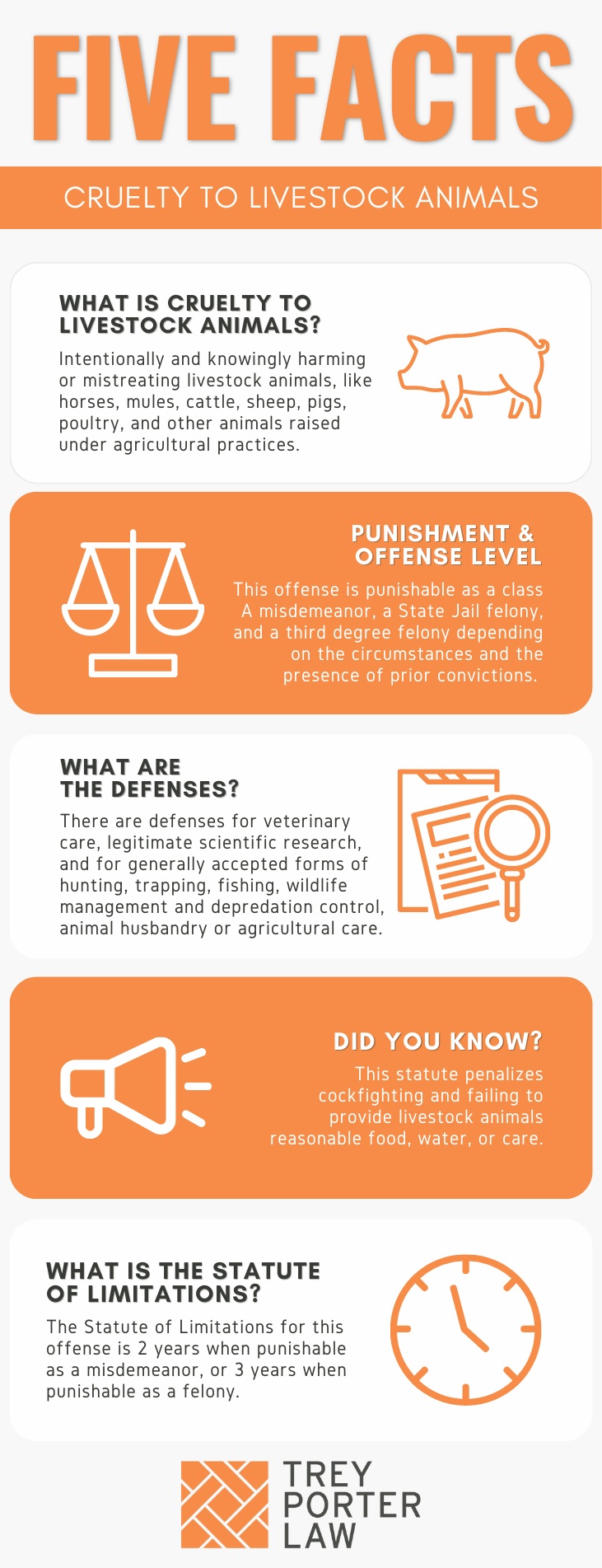WHAT IS CRUELTY TO LIVESTOCK ANIMALS IN TEXAS?
The Texas law against cruelty to livestock animals prohibits intentionally or knowingly mistreating cattle, horses, sheep, swine, fowl, and other livestock animals.

- What are examples of cruelty to livestock animals in Texas? Texas Penal Code Section 42.09 specifies types of conduct constituting cruelty to livestock animals. A person commits livestock animal cruelty by:
-
- torturing a livestock animal;
- failing to provide necessary food, water, or care for a livestock animal in the person’s custody;
- abandoning a livestock animal in the person’s custody;
- transporting or confining a livestock animal in a cruel and unusual manner;
- administering poison to a livestock animal belonging to another, without legal authority and without the owner’s consent;
- causing a livestock animal to fight another animal;
- using a livestock animal as a lure in dog race training or dog coursing on a racetrack;
- tripping a horse; or
- seriously overworking a livestock animal.
WHAT IS THE CRUELTY TO LIVESTOCK ANIMALS LAW IN TEXAS?
Tex. Penal Code § 42.09. CRUELTY TO LIVESTOCK ANIMALS.
(a) A person commits an offense if the person intentionally or knowingly:
(1) tortures a livestock animal;
(2) fails unreasonably to provide necessary food, water, or care for a livestock animal in the person’s custody;
(3) abandons unreasonably a livestock animal in the person’s custody;
(4) transports or confines a livestock animal in a cruel and unusual manner;
(5) administers poison to a livestock animal, other than cattle, horses, sheep, swine, or goats, belonging to another without legal authority or the owner’s effective consent;
(6) causes one livestock animal to fight with another livestock animal or with an animal as defined by Section 42.092;
(7) uses a live livestock animal as a lure in dog race training or in dog coursing on a racetrack;
(8) trips a horse; or
(9) seriously overworks a livestock animal.
(c) An offense under Subsection (a)(2), (3), (4), or (9) is a Class A misdemeanor, except that the offense is a state jail felony if the person has previously been convicted two times under this section, two times under Section 42.092, or one time under this section and one time under Section 42.092. An offense under Subsection (a)(1), (5), (6), (7), or (8) is a state jail felony, except that the offense is a felony of the third degree if the person has previously been convicted two times under this section, two times under Section 42.092, or one time under this section and one time under Section 42.092.
(d) It is a defense to prosecution under Subsection (a)(8) that the actor tripped the horse for the purpose of identifying the ownership of the horse or giving veterinary care to the horse.
(e) It is a defense to prosecution for an offense under this section that the actor was engaged in bona fide experimentation for scientific research.
(f) It is an exception to the application of this section that the conduct engaged in by the actor is a generally accepted and otherwise lawful:
(1) form of conduct occurring solely for the purpose of or in support of:
(A) fishing, hunting, or trapping; or
(B) wildlife management, wildlife or depredation control, or shooting preserve practices as regulated by state and federal law; or
(2) animal husbandry or agriculture practice involving livestock animals.
(g) This section does not create a civil cause of action for damages or enforcement of this section.
WHAT IS THE PENALTY CLASS FOR CRUELTY TO LIVESTOCK ANIMALS IN TEXAS?
The penalty classification for cruelty to livestock animals depends on the severity of the conduct, and whether the accused has been previously convicted of animal cruelty.
- Class A misdemeanor, punishable by up to one year in county jail, if the person has no prior convictions, and committed the offense by:
- failing to provide necessary food, water, or care for a livestock animal in the person’s custody;
- abandoning a livestock animal in the person’s custody;
- transporting or confining a livestock animal in a cruel and unusual manner; or
- seriously overworking a livestock animal;
- State jail felony, punishable by 180 days to two years in a state jail facility, if the person commits a Class A misdemeanor animal cruelty, and has two previous animal cruelty convictions, or has no prior convictions, and commits the offense by:
- torturing a livestock animal;
- administering poison to a livestock animal without legal authority, and without the owner’s consent;
- causing a livestock animal to fight with another animal;
- using a live livestock animal as a lure in a dog race training or in dog coursing on a racetrack; or
- tripping a horse;
- Third degree felony, punishable by two to ten years in prison, if:
- the person commits a state jail felony animal cruelty, and has two prior felony convictions for animal cruelty.
WHAT IS THE PUNISHMENT RANGE FOR CRUELTY TO LIVESTOCK ANIMALS IN TEXAS?
The punishment range for cruelty to livestock animals depends on the penalty classification.
- Third degree felony: two to ten years in prison, maximum $10,000 fine;
- State jail felony: 180 days to two years in a state jail facility, maximum $10,000 fine;
- Class A misdemeanor: up to one year in jail, maximum $4,000 fine.
WHAT ARE THE PENALTIES FOR CRUELTY TO LIVESTOCK ANIMALS IN TEXAS?
A person charged with cruelty to livestock animals may be eligible for probation after a conviction, or deferred adjudication without a conviction. The term of community supervision for a third degree felony may not exceed ten years.
The term of community supervision for a state jail felony ranges between two and five years, with the possibility of extending supervision for up to ten years. Community supervision for a Class A misdemeanor may not exceed two years.
A judge may order up to 30 days’ confinement in jail as a condition of misdemeanor community supervision, and up to 180 days in jail as a condition of felony community supervision.
- Are there special conditions of probation or deferred adjudication for animal cruelty in Texas? Texas Code of Criminal Procedure article 42A.511 permits a judge to order a person on community supervision for animal cruelty to relinquish custody of all animals, complete psychological counseling, and may prohibit the person from possessing or owning animals.
WHAT ARE THE DEFENSES TO CRUELTY TO LIVESTOCK ANIMALS IN TEXAS?
A person accused of cruelty to livestock animals may raise one or more of the defenses authorized by the statute, in addition to negating at least one of the elements the State must prove at trial. It is a defense to horse tripping if the person was attempting to identify the owner, or was giving veterinary care. It is also a defense to animal cruelty if the person was engaged in bona fide scientific research experiments.
- Can a person be charged with cruelty to livestock animals for hunting? No, as long as the person was legally hunting in a generally accepted form. The Texas cruelty to livestock statute contains an exception for a person whose conduct is a generally accepted and otherwise lawful form of conduct for the sole purpose of or in support of: (1) fishing, hunting, or trapping; (2) wildlife management, wildlife or depredation control, or shooting preserve practices; or (3) animal husbandry or agriculture practice involving livestock animals.
WHAT IS THE STATUTE OF LIMITATIONS FOR CRUELTY TO LIVESTOCK ANIMALS IN TEXAS?
The limitation period for cruelty to livestock animals classified as a felony is three years. If categorized as a Class A misdemeanor, the limitation period is two years.
CRUELTY TO LIVESTOCK ANIMALS IN TEXAS
A person commits cruelty to livestock animals by neglecting animals under a person’s care, torturing an animal, causing animals to fight, and other forms of mistreatment. Texas law requires anyone who assumes custody of an animal to provide it with reasonable care, and prohibits all persons from committing violent acts of mistreatment against animals.
TEXAS CRUELTY TO LIVESTOCK ANIMALS COURT CASES
The case law regarding cruelty to livestock animals in Texas gives examples of punishable conduct.
- In Hoffman v. State, 207 horses were seized from the defendant for neglect. She was prosecuted and ultimately convicted for cruelty to livestock animals. The evidence at trial showed the horses were malnourished, some were emaciated, their hooves were not maintained, they all suffered from parasites, had significant dental problems, and had untreated wounds. The appellate court affirmed the conviction for the defendant’s failure to provide reasonable food, water, and care.
















